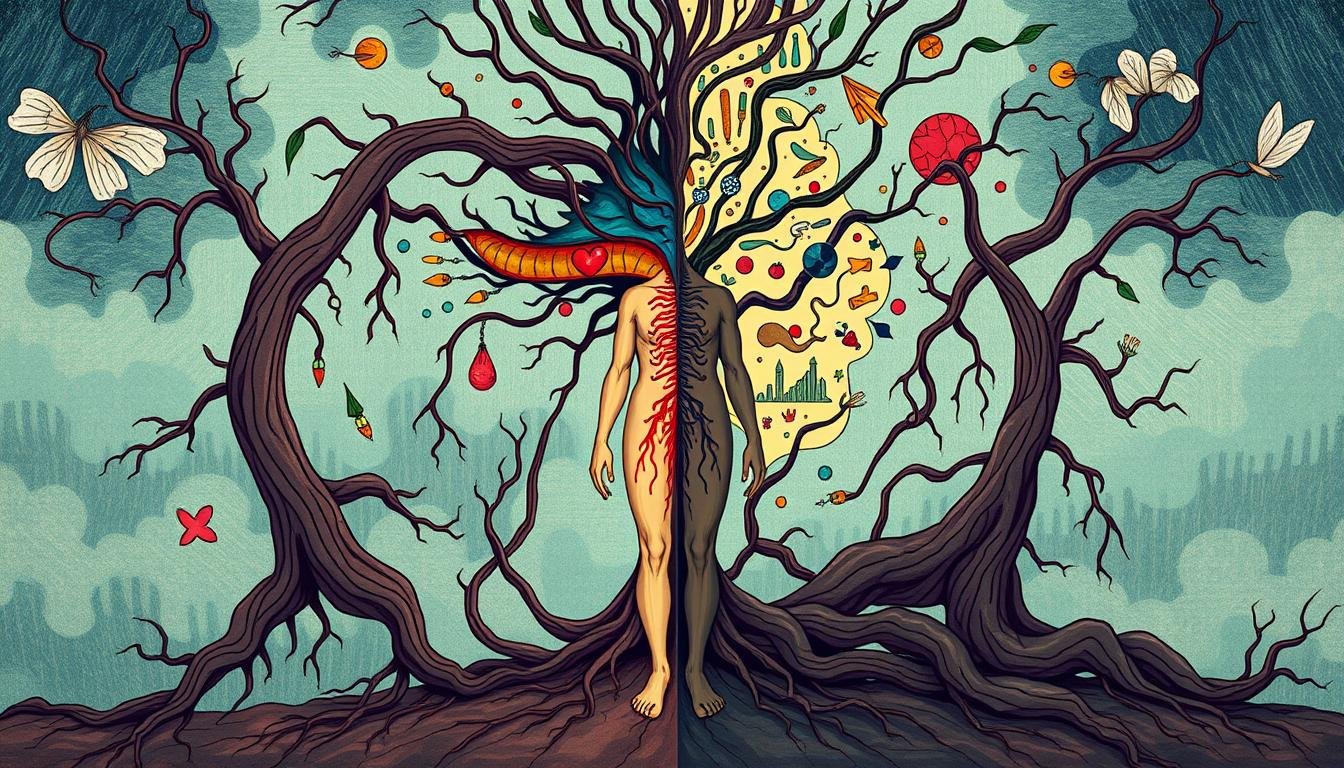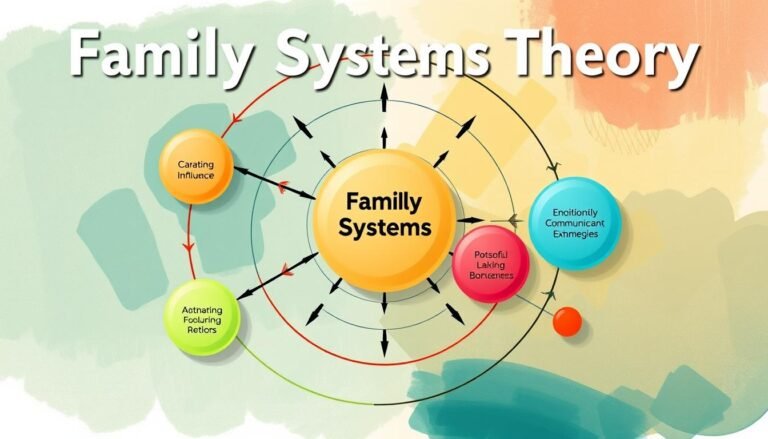Understanding Psychosomatic Disorder
Ever felt sick when stressed, even without a clear reason? This is called psychosomatic disorder. It shows how our mind and body are connected. Our thoughts can make us feel physical pain.
These disorders can affect almost any part of our body. They often happen in areas we can’t control, like our heart and stomach. Conditions like high blood pressure and migraines show how our mind affects our body.
Recent studies find most diseases have a mind-body link. This idea changes how we see health and sickness. It shows our thoughts and feelings are key to our health, leading to new treatments.
We’ll look into how stress affects our body, the science behind it, and how to treat it. Learning about psychosomatic disorders helps us find better health and happiness for many people.
What is Psychosomatic Disorder
Psychosomatic disorder happens when our mind affects our body. It’s a common issue, affecting about 5-7% of people. Those with it have physical symptoms without a clear medical reason.
Defining the Mind-Body Connection
The mind-body connection is central to psychosomatic disorders. Our emotions can cause physical problems. For example, stress might lead to headaches or stomach issues.
Common Manifestations and Symptoms
Somatization shows up as various physical complaints. These can include:
- Chronic pain
- Digestive problems
- Fatigue
- Dizziness
- Racing heart
These symptoms are real and can really impact our daily lives. They can change based on age and gender. For example, kids might show physical signs of stress because they can’t express it well.
The Role of Psychological Stress
Psychological stress is a big factor in psychosomatic disorders. Long-term stress can weaken our immune system. It can also lead to the release of harmful chemicals like adrenaline.
| Stress Type | Effect |
|---|---|
| Positive Stress (Eustress) | Can enrich life |
| Negative Stress | Impacts mental and physical health |
Understanding psychosomatic disorders is key to finding good treatments. Treatments might include therapy, stress management, and sometimes medication. This helps address both the mind and body aspects of the condition.
The Science Behind Mind-Body Interaction
The nervous system is key in psychosomatic disorders. Stress can cause physical symptoms, like Conversion Disorder and Psychogenic Pain. Knowing this helps doctors treat patients better, who face both physical and emotional challenges.
The Nervous System’s Response
Our bodies respond to stress through the nervous system. This can lead to real symptoms, even without a medical issue. For instance, stress can cause headaches, stomach problems, or muscle tension. Sometimes, these symptoms can turn into serious conditions, like Conversion Disorder.
The Vagus Nerve Connection
The vagus nerve is vital in mind-body interaction. It links the brain to organs, affecting heart rate and digestion. When stressed, it can cause symptoms like abdominal pain. This shows why emotional stress often leads to physical discomfort.
Biological Mechanisms of Stress Response
Stress triggers biological changes in our bodies. These changes can affect our immune system, hormone levels, and gene function. Chronic stress can lead to health problems, including Psychogenic Pain and other psychosomatic conditions.
| Stress Response | Physical Effect | Potential Outcome |
|---|---|---|
| Increased heart rate | Cardiovascular strain | Heart disease risk |
| Muscle tension | Chronic pain | Psychogenic Pain |
| Altered immune function | Reduced immunity | Increased illness |
Common Physical Manifestations and Symptoms
Psychosomatic disorder is often linked to hypochondriasis. It shows up in many physical symptoms. These symptoms are real and can really affect your daily life, even without a clear cause.
Pain is the most common symptom in somatic symptom disorder. This condition makes people focus too much on physical discomfort.
People with psychosomatic disorder may experience:
- Hypertension
- Respiratory issues
- Gastrointestinal problems
- Migraine headaches
- Pelvic pain
- Sexual dysfunction
- Skin conditions
- Ulcers
- Fatigue
- Insomnia
These symptoms show how the body reacts to stress and emotions. Too much worry about these symptoms can cause big problems and disability.
Risk factors for somatic symptom disorder include anxiety, depression, stressful life events, and lower socio-economic status. It can lead to poor health, relationship issues, and work problems. Getting help early and managing stress can help manage psychosomatic disorders.
“The mind and body are not separate. What affects one, affects the other.”
Treatment for psychosomatic disorder often includes regular doctor visits and psychotherapy. This helps change thinking and behavior. Sometimes, antidepressants or anti-anxiety meds are used to manage symptoms.
Diagnosis and Treatment Approaches
Diagnosing and treating psychosomatic disorders needs a detailed plan. Stress-related illnesses often show symptoms that mix physical and mental health issues.
Patient-Centered Care Methods
Doctors first look for stress signs before suggesting treatments. The DSM-5 helps in diagnosing, focusing on symptoms that cause distress and health anxiety lasting more than six months.
Holistic Treatment Strategies
A holistic approach is essential for managing psychosomatic disorders. This may include:
- Lifestyle changes (balanced diet, vitamin supplements, limiting caffeine)
- Physical activity to improve both bodily and mental health
- Yoga and meditation for stress relief
- Osteopathy to positively influence nervous and circulatory systems
Therapeutic Interventions
Several therapies are effective in treating stress-related illnesses:
- Cognitive Behavioral Therapy (CBT) to address physical symptoms linked to psychological distress
- Group psychotherapy sessions with 5-15 patients
- Acupuncture for anxiety and depression
Medical Management Options
Medical interventions may include:
- Pharmacotherapy using antidepressants and anxiolytics
- Electroconvulsive therapy (ECT) for severe depression
Regular visits to healthcare providers and mental health professionals are key in managing psychosomatic disorders. A mix of professional treatment and self-care strategies offers the best chance for relief from stress-related illnesses.
Conclusion
Psychosomatic disorders show us how important the mind-body connection is in healthcare. These conditions affect 4-6% of Americans. They show we need to care for patients in a more complete way.
Women are more likely to get these disorders, with a 10:1 ratio to men. This highlights the need for care that fits each gender’s needs.
These illnesses have a big impact. Patients with them use more medical services and spend more on healthcare. For example, chronic pelvic pain affects 38 in 1000 women aged 15-73.6. This costs healthcare systems millions every year.
Studies also show that older people are more likely to get these disorders. In Catalonia, 19.8% of women reported feeling anxious or depressed, compared to 10.3% of men. This shows we need to focus on mental health care in a way that suits each gender.
As we learn more about the mind-body connection, we find better ways to treat these disorders. The CARE MD model uses cognitive behavioral therapy and mindfulness-based therapies. It shows promise in managing psychosomatic disorders. By treating both the mind and body, we can make patients’ lives better.
Source Links
- Psychosomatic disorder | Mental Health, Stress, & Anxiety | Britannica
- Psychosomatic disorders
- How Your Stress and Depression Can Really Make You Sick
- Psychosomatic syndromes, somatization and somatoform disorders – PubMed
- Psychosomatic Disorders
- The Four-Cluster Spectrum of Mind-Body Interrelationships: An Integrative Model
- Mind and body: how the health of the body impacts on neuropsychiatry
- The American Psychosomatic Society – integrating mind, brain, body and social context in medicine since 1942 – BioPsychoSocial Medicine
- Somatic symptom disorder – Symptoms and causes
- What is Somatic Symptom Disorder?
- Psychosomatic Disorder Treatment Options
- Somatic symptom disorder – Diagnosis and treatment
- Psychosomatic disorders – O&G Magazine
- Analysis of Psychosomatic Disorders According to Age and Sex in a Rural Area: A Population-Based Study








